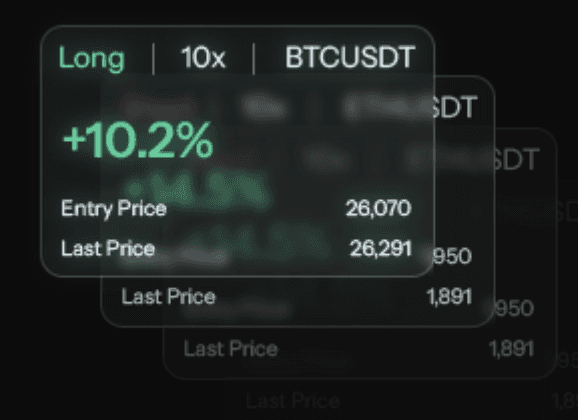/
Technical Indicator Categories: Which Market Categories & Elements Can Elevate Your Trading
/
Technical Indicator Categories: Which Market Categories & Elements Can Elevate Your Trading
/
Technical Indicator Categories: Which Market Categories & Elements Can Elevate Your Trading
Technical Indicator Categories: Which Market Categories & Elements Can Elevate Your Trading
Jul 17, 2023
Whether you’ve just taken a dip into the trading space or you’re a seasoned veteran, you have surely come across the term “technical indicators”, have some knowledge about them and what they’re for. There’s a variety of technical indicator categories, each indicating a different element of the asset’s price movement. Let’s explore some of these categories and take a few examples.
1. Trend Indicators:
a) Our journey's initial stop is trend indicators. They assist you in determining the market's general direction, as their name implies. These are the top two trend indicators:
Moving Averages (MA) are like your friend who helps you ride out the hiccups in the road. It determines the average price over a predetermined time period and generates a line that follows the price movement. In order to identify long-term trends, people frequently employ the 50-day and 200-day moving averages.
b) Parabolic SAR: Although it may sound a little complicated, the Parabolic Stop and Reverse (SAR) indication is actually rather simple. In order to indicate potential reversal points, it places dots above or below the price chart. The trend may be changing when the dots reverse their directions.
2. Oscillators (Momentum):
The cool kids of the indicator world are oscillators. They remain in the middle of the chart, bouncing back and forth between overbought and oversold levels. Here are two favorites:
a) Relative Strength Index (RSI): RSI is the smooth talker who knows when to party and when to chill. It lets you determine whether an asset is overbought (above 70) or oversold (below 30) by oscillating between 0 and 100. An impending trend reversal may be present when the RSI reaches extended levels.
b) Stochastic Oscillator: Your grandma would give you this indicator as a lucky charm. It consists of two lines, %K and %D, and has a range of 0 to 100. Overbought situations are indicated when these lines cross over 80, and oversold conditions are indicated when they fall below 20.
3. Volume Indicators:
Consistently dancing along the market's price movement are volume indicators. They quantify the volume of shares or contracts traded, which provides information about market strength. Consider these two well-liked volume indicators:
a) Volume Moving Average (VMA) eliminates volume swings and displays the average volume over a predetermined time. It aids in the detection of volume trends and possible breakouts or breakdowns.
b) On-Balance Volume (OBV): OBV is the extroverted dude who adds or subtracts cumulative volume in response to price changes. It generates a running total that reveals whether traffic is entering or exiting an asset.
4. Volatility Indicators:
Volatility indicators are the risk-takers; they measure the rate and magnitude of price movements. Two of the most well-known volatility indicators are listed below:
a) Bollinger Bands: These bands, which encircle the price, resemble flexible rubber bands. A moving average, an upper band (standard deviations above the average), and a lower band (standard deviations below the average) make up each of them. The bands indicate lesser volatility as they close in and higher volatility when they open up.
b) Average True Range (ATR): ATR is the adventurer that informs you of the normal movement of an asset over a given period of time. Based on current market activity, it assists you in establishing reasonable stop-loss and take-profit levels.
Conclusion:
This was a little taste of the fascinating and vast world of trading indicators.
Keep in mind that while these tools aren't magic wands, they can nonetheless offer insightful information to support your trading choices. Practise, try new things, and never stop learning!
You'll learn which indicators work best for your trading strategy as you acquire experience. So educate yourself, maintain your curiosity, and enjoy discovering the fascinating world of trading! I wish you success in your endeavours and prosperous trades. Happy & safe trading!

Technical Indicator Categories: Which Market Categories & Elements Can Elevate Your Trading
Jul 17, 2023
Whether you’ve just taken a dip into the trading space or you’re a seasoned veteran, you have surely come across the term “technical indicators”, have some knowledge about them and what they’re for. There’s a variety of technical indicator categories, each indicating a different element of the asset’s price movement. Let’s explore some of these categories and take a few examples.
1. Trend Indicators:
a) Our journey's initial stop is trend indicators. They assist you in determining the market's general direction, as their name implies. These are the top two trend indicators:
Moving Averages (MA) are like your friend who helps you ride out the hiccups in the road. It determines the average price over a predetermined time period and generates a line that follows the price movement. In order to identify long-term trends, people frequently employ the 50-day and 200-day moving averages.
b) Parabolic SAR: Although it may sound a little complicated, the Parabolic Stop and Reverse (SAR) indication is actually rather simple. In order to indicate potential reversal points, it places dots above or below the price chart. The trend may be changing when the dots reverse their directions.
2. Oscillators (Momentum):
The cool kids of the indicator world are oscillators. They remain in the middle of the chart, bouncing back and forth between overbought and oversold levels. Here are two favorites:
a) Relative Strength Index (RSI): RSI is the smooth talker who knows when to party and when to chill. It lets you determine whether an asset is overbought (above 70) or oversold (below 30) by oscillating between 0 and 100. An impending trend reversal may be present when the RSI reaches extended levels.
b) Stochastic Oscillator: Your grandma would give you this indicator as a lucky charm. It consists of two lines, %K and %D, and has a range of 0 to 100. Overbought situations are indicated when these lines cross over 80, and oversold conditions are indicated when they fall below 20.
3. Volume Indicators:
Consistently dancing along the market's price movement are volume indicators. They quantify the volume of shares or contracts traded, which provides information about market strength. Consider these two well-liked volume indicators:
a) Volume Moving Average (VMA) eliminates volume swings and displays the average volume over a predetermined time. It aids in the detection of volume trends and possible breakouts or breakdowns.
b) On-Balance Volume (OBV): OBV is the extroverted dude who adds or subtracts cumulative volume in response to price changes. It generates a running total that reveals whether traffic is entering or exiting an asset.
4. Volatility Indicators:
Volatility indicators are the risk-takers; they measure the rate and magnitude of price movements. Two of the most well-known volatility indicators are listed below:
a) Bollinger Bands: These bands, which encircle the price, resemble flexible rubber bands. A moving average, an upper band (standard deviations above the average), and a lower band (standard deviations below the average) make up each of them. The bands indicate lesser volatility as they close in and higher volatility when they open up.
b) Average True Range (ATR): ATR is the adventurer that informs you of the normal movement of an asset over a given period of time. Based on current market activity, it assists you in establishing reasonable stop-loss and take-profit levels.
Conclusion:
This was a little taste of the fascinating and vast world of trading indicators.
Keep in mind that while these tools aren't magic wands, they can nonetheless offer insightful information to support your trading choices. Practise, try new things, and never stop learning!
You'll learn which indicators work best for your trading strategy as you acquire experience. So educate yourself, maintain your curiosity, and enjoy discovering the fascinating world of trading! I wish you success in your endeavours and prosperous trades. Happy & safe trading!

Technical Indicator Categories: Which Market Categories & Elements Can Elevate Your Trading
Jul 17, 2023
Whether you’ve just taken a dip into the trading space or you’re a seasoned veteran, you have surely come across the term “technical indicators”, have some knowledge about them and what they’re for. There’s a variety of technical indicator categories, each indicating a different element of the asset’s price movement. Let’s explore some of these categories and take a few examples.
1. Trend Indicators:
a) Our journey's initial stop is trend indicators. They assist you in determining the market's general direction, as their name implies. These are the top two trend indicators:
Moving Averages (MA) are like your friend who helps you ride out the hiccups in the road. It determines the average price over a predetermined time period and generates a line that follows the price movement. In order to identify long-term trends, people frequently employ the 50-day and 200-day moving averages.
b) Parabolic SAR: Although it may sound a little complicated, the Parabolic Stop and Reverse (SAR) indication is actually rather simple. In order to indicate potential reversal points, it places dots above or below the price chart. The trend may be changing when the dots reverse their directions.
2. Oscillators (Momentum):
The cool kids of the indicator world are oscillators. They remain in the middle of the chart, bouncing back and forth between overbought and oversold levels. Here are two favorites:
a) Relative Strength Index (RSI): RSI is the smooth talker who knows when to party and when to chill. It lets you determine whether an asset is overbought (above 70) or oversold (below 30) by oscillating between 0 and 100. An impending trend reversal may be present when the RSI reaches extended levels.
b) Stochastic Oscillator: Your grandma would give you this indicator as a lucky charm. It consists of two lines, %K and %D, and has a range of 0 to 100. Overbought situations are indicated when these lines cross over 80, and oversold conditions are indicated when they fall below 20.
3. Volume Indicators:
Consistently dancing along the market's price movement are volume indicators. They quantify the volume of shares or contracts traded, which provides information about market strength. Consider these two well-liked volume indicators:
a) Volume Moving Average (VMA) eliminates volume swings and displays the average volume over a predetermined time. It aids in the detection of volume trends and possible breakouts or breakdowns.
b) On-Balance Volume (OBV): OBV is the extroverted dude who adds or subtracts cumulative volume in response to price changes. It generates a running total that reveals whether traffic is entering or exiting an asset.
4. Volatility Indicators:
Volatility indicators are the risk-takers; they measure the rate and magnitude of price movements. Two of the most well-known volatility indicators are listed below:
a) Bollinger Bands: These bands, which encircle the price, resemble flexible rubber bands. A moving average, an upper band (standard deviations above the average), and a lower band (standard deviations below the average) make up each of them. The bands indicate lesser volatility as they close in and higher volatility when they open up.
b) Average True Range (ATR): ATR is the adventurer that informs you of the normal movement of an asset over a given period of time. Based on current market activity, it assists you in establishing reasonable stop-loss and take-profit levels.
Conclusion:
This was a little taste of the fascinating and vast world of trading indicators.
Keep in mind that while these tools aren't magic wands, they can nonetheless offer insightful information to support your trading choices. Practise, try new things, and never stop learning!
You'll learn which indicators work best for your trading strategy as you acquire experience. So educate yourself, maintain your curiosity, and enjoy discovering the fascinating world of trading! I wish you success in your endeavours and prosperous trades. Happy & safe trading!

Supercharge your trading game with Market Mapper today!




